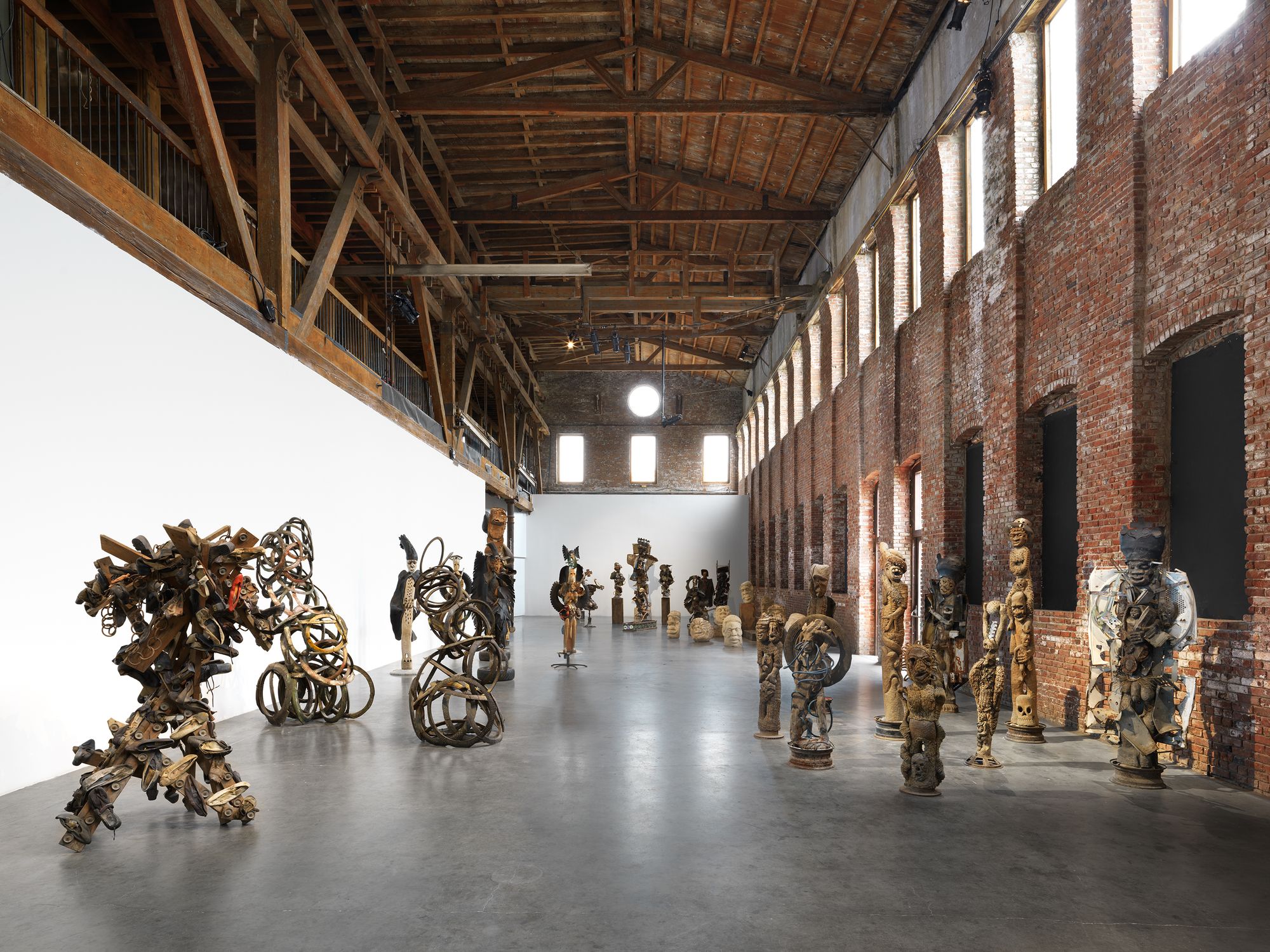
PÒTOPRENS: The Urban Artists of Port-au-Prince
PÒTOPRENS: The Urban Artists of Port-au-Prince brings together the work of over 25 artists working in the Haitian capital. The exhibition, on view September 7 to November 11, 2018, highlights Port-au-Prince’s many diverse centers of cultural production, informal street life, religious heritage, and mythologies to create a compelling portrait of a historically significant and intensely complex city in flux. Co-curated by Haitian-American artist and curator Edouard Duval-Carrié and British artist and curator Leah Gordon, PÒTOPRENS is a large-scale exhibition of sculptures, photographs, and films, accompanied by a garden installation of a recreated Port-au-Prince barbershop as well as extensive public programming.
Port-au-Prince is a polyphonic city declaring its cultural history via multiple voices. While its infrastructure is deeply compromised, the gap between rich and poor is immense, and the 2010 earthquake destroyed many of its major buildings, Port-au-Prince continues to be one of the most vibrant and creative cities in the Caribbean. Hence, PÒTOPRENS is not simply a survey show, nor is it a comprehensive snapshot of contemporary Haitian art. It is an exhibition that uses the city of Port-au-Prince as a lens through which to view the chaotic intersections of history, music, politics, religion, magic, architecture, art, and literature— to enable the viewer to reflect upon the past and speculate about the future of this vital city and its country.
The first floor exhibition presents a diverse group of sculptures including sequined Vodou flags, stone and wood carvings, and found object assemblages, most of which have never before been seen in the United States. The sculptural installation mirrors the organization of the city itself by highlighting specific districts in Port-au-Prince where art is produced—each with its own particular subjects, forms, and materials. The neighborhood of Bel Air, situated on a hill that rises behind the remains of the Catholic Cathedral in downtown Port-au- Prince, has a rich concentration of Vodou flag artists and sequin sculptors—a tradition alleged to have originated from the royal flags and banners of Benin. Rivière Froide is a community of sculptors living on the banks of the river that passes through the city’s Carrefour neighborhood, who carve their work from limestone and other detritus found at the water’s edge. At the southern end of Grand Rue, the main avenue that runs north to south through downtown Port-au-Prince, is a close-knit community sited in the area that has traditionally produced small handicrafts for the ever-diminishing tourism market. Taking readymade and recycled materials from the makeshift car repair district nearby, the Grand Rue artists make assemblages that transform the detritus of the world’s failing economies into apocalyptic images. Sculptors include Katelyne Alexis, Karim Bléus, Jean Hérard Céleur, Myrlande Constant, Lhérisson Dubréus, Ronald Edmond, André Eugène, Guyodo (Frantz Jacques), Ti Pelin (Jean Salomon Horace), Evel Romain, and Yves Telemaque.
The exhibition continues on the second and third floors where a selection of photographs and films further contextualize Port-au-Prince as a far more complex city than is often represented in the news. Photographs by Josué Azor, Maggie Steber, and Roberto Stephenson portray the city as one of radical sexual politics, seductive interiors, and informal economies, as well as loss and destruction. Azor sheds light on the queer underground scene in Port-au-Prince; Steber captures Grand Rue in the aftermath of the 2010 earthquake; and Stephenson photographs the city’s architecture including the famed “Gingerbread” homes of Pacot. Meanwhile, the film series—with selections ranging from art film to documentary—illustrates many decades of the city’s history.
Additionally, an installation in the Pioneer Works garden pays tribute to Port-au-Prince’s innumerable barbershops, which are not only fundamental to the city’s social cohesion but are unique sculptural objects in their own right. Often constructed and furnished with offcast materials, the barbershops are distinguished by vivid portraits of both foreign and domestic athletes, rappers, and models. Organized by Richard Fleming, the installation at Pioneer Works features newly commissioned portraits by painter Michel Lafleur, and will provide visitors the opportunity to get a haircut from a Haitian barber.
PÒTOPRENS was born out of a 2015 collaboration between Pioneer Works, the 4th Ghetto Biennale in Port-Au-Prince, and Clocktower Radio that resulted in Radyo Shak, a pirate arts radio station in Port-Au-Prince. The exhibition was curated by Edouard Duval-Carrié and Leah Gordon, and organized by Pioneer Works Founding Artistic Director Gabriel Florenz with special advisor Jean-Daniel Lafontant.
Funding for PÒTOPRENS: The Urban Artists of Port-au-Prince is generously provided by the Jerome L. Greene Foundation and the National Endowment for the Arts.
The Jerome L. Greene Foundation supports select programs that make a significant impact on the lives of all New Yorkers in the arts, education, medicine and social justice. The Foundation’s 40-year history is grounded in the vision of its founder, Jerry Greene, to give back to the city he loved. Today the Foundation honors his commitment by continuing to fund quality organizations throughout New York – such as Pioneer Works, The Whitney Museum, City Center and the Apollo – and by identifying new ways to increase access to the arts and education, create opportunity for ground-breaking medical research, and help ensure social justice for all.
![]()